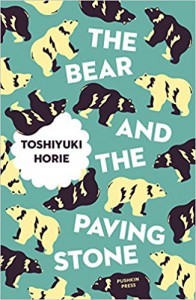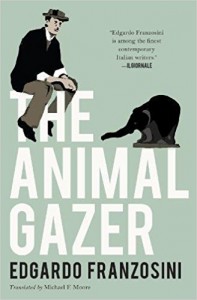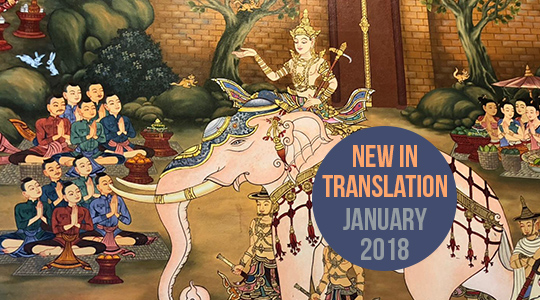Every month, our staff members pick three notable new releases in world literature to review. The first month of 2018 brings us short fiction from Japan and novels from Germany and Italy.

The Bear and the Paving Stone by Toshiyuki Horie, translated from the Japanese by Geraint Howells, Pushkin Press
Reviewed by Theophilus Kwek, Editor-at-Large for Singapore
Mention ‘contemporary Japanese fiction’ to the average reader and bestselling names like Haruki Murakami, Ruth Ozeki, and Keigo Higashino might come to mind; or indeed last year’s Nobel laureate, the British novelist Kazuo Ishiguro. From that perspective, at least, Toshiyuki Horie can be considered one of the modern Japanese canon’s best-kept secrets, happily resurfaced for an Anglophone audience by the ever-intrepid Pushkin Press. A critic, translator, and professor of literature, Horie has garnered numerous accolades for his fiction and essays, and is also—as the three novellas collected here reveal—a masterly prose stylist, a ruthlessly effective narrator, and a seasoned traveller between the real and imagined geographies of experience and history, dream and memoir, and past and present.
The first and longest section of the volume contains Horie’s novella “The Bear and the Paving Stone,” which won the Akutagawa Prize in 2001, and lends this volume its title. The tale opens in a strange, allegorical dream-sequence that ends just as abruptly when the narrator wakes, alone, in a rural farmhouse in Normandy. Drawing on Horie’s own time as a graduate student at the Sorbonne, the story unfolds with exquisite pacing into a long-awaited reunion between two unlikely college pals: the narrator (then a student from Japan, now a professional translator) and Yann, a free-spirited, petánque-playing photographer. As they embark on a breakneck drive to see the sun set over Mont St Michel from Yann’s favourite spot on the coast, we are plunged as if into another dream: this time, comprising the layered narratives of French intellectual history, the Holocaust and its aftershocks, and a post-modern, international friendship. Ghostly historical figures such as Émile Littré, Jorge Semprún, and Bruno Bettelheim haunt these pages with a sense of driving, almost teleological purpose, but the two friends’ conversation somehow remains light, and movingly human, throughout.
Much of the credit for this goes to Geraint Howells’ unvarnished translation, which in its plain-speaking ease captures something of Horie’s deadpan humour. Perhaps Howells’ background as a video game translator has bequeathed him an uncanny sense of comic idiom and timing; if so, we are incredibly lucky for it. Particularly memorable is how the inevitable distance of translation is deliberately reproduced, at some junctures, to leaven the dialogue. As Horie’s narrator has it:
A detail that could have been shared in seconds went on much longer, as though an older child were explaining something to a younger child. A lot of time passed without my noticing it. I went back over what I had written in my letters […] Yann listened, and then, in his own entertaining way, told the story of how he ended up settling in the village.
It is precisely the awkwardness created by the two friends meeting for the first time in years, across various spans of time, language, and culture, that provides room for them to reach out in telling ways to lessen each other’s discomfort. A clue, perhaps, to how we might understand the hidden exchanges between every writer-translator partnership—especially a pair as successful as these two.
The two remaining titles in this volume are more compact, but also glitter with the energy and beauty of the first. To read them is to watch an expert at work who is committed to bringing his whole person to his craft, and to enter a tender and personal world that is continuous with the particular universes of his characters. In “The Sandman is Coming,” an older narrator finds himself at the beach with his deceased friend’s sister and her daughter, and a search for a lost earring (followed by a stubborn race to build a sandcastle before the high tide) becomes a moving meditation on age and temporality. The third tale, “In the Old Castle,” approaches the question of time from a different angle: in it, the narrator climbs into an abandoned castle that has been restored together with his friend, but they are separated by a short-tempered groundskeeper and he must find a way out before dark. If Horie gives very little away in both stories by way of heart-warming endings or clear-cut moral lessons, the storytelling itself—which blends the whimsy of fable with the pang of truth – is always worth the journey.
There is much in Horie’s fiction that remains rare among his Anglophone contemporaries; among other qualities: an appetite for historical erudition, unflinching personal engagement, and a voice that is austere without losing its warmth. In this fine selection, he and Howells have transported us convincingly beyond our own familiar worlds, and left us with much to sample and admire.

River by Esther Kinsky, translated from the German by Iain Galbraith, Fitzcarraldo Editions
Reviewed by Jacob Silkstone, Assistant Managing Editor
In the first chapter of To The River, Olivia Laing explains why she feels “haunted by waters,” and by rivers in particular:
Unlike a lake or sea, a river has a destination and there is something about the certainty with which it travels that makes it very soothing, particularly for those who’ve lost faith with where they’re headed.
The nameless narrator of Esther Kinsky’s River (originally Am Fluß; the preposition has been lost in translation) is suffering from a Laing-like loss of faith and lack of direction. She chooses to excise herself “from the life I had led in town, just as one might cut a figure out of a landscape or group photo” and enter into a new existence on the margins of London.
Starting from Hackney, where the Lea “[divides] the town from open terrain,” Kinsky’s narrator progresses from river to river and country to country, “[making] a home for myself by walking.” Each journey follows its own oneiric logic and is described in sinuous, somnambular sentences; the parallels with W.G. Sebald stretch beyond the hazy black-and-white photographs which appear at regular intervals throughout the book.
And yet the further you travel through River, the more the book seems to be concerned with people rather than places. These are far from being the reveries of a solitary walker. Kinsky describes the Rhine as symbolising “dislocation, confusion and unpredictability in a world that craved order,” and River becomes a celebration of people who exist on the edges of the predictable world and refuse to submit to ideas of order. Recurring characters include “Sonja-turned-Gabriella” (a girl like “a sepulchral angel, its face worn by wind and weather,” first encountered in Abney Park Cemetery), a formerly “world-famous” circus rider wearing a threadbare gold leotard beneath his coat, and “the King,” who appears “melancholy in his majesty, far from his country” in a London park at dusk.
Each life seems dredged up and reclaimed from under the pressing weight of the passing years, and the disparate cast is connected by a shared sense of liminality: in Canada, the narrator is drawn to “a quarter of sects and runaways who lived in and wore out the old wooden houses, pending the day when the Great Improvement would sweep them out with a few strokes of the broom.” River is a book concerned with everything that will be lost when “the Great Improvement” arrives.
There’s a timeless quality to River, too: the names of the four seasons and the four elements (“air” is most frequently associated with storms; the season is usually autumn or winter) are intoned over and over, and the book’s structure is openly cyclical. How much is fact and how much is pure fiction? It hardly matters. River exists in a hinterland between personal and universal strands of truth.
Towards the end of the final chapter, as the narrator’s belongings are packed and “the King” first flies and then inevitably falls, sending the birds flapping away “with a great whirring of wings,” it’s hard to escape the feeling that Esther Kinsky has produced a minor-key masterpiece. Iain Galbraith’s English translation is note-perfect, and River could well be one of the best new translations of 2018.

The Animal Gazer by Edgardo Franzosini, translated from the Italian by Michael F. Moore, New Vessel Press
Reviewed by Cassie Lawrence, Senior Executive Assistant
The Animal Gazer of the title is Rembrandt Bugatti, a real-life artist who worked up to and during World War I to create particularly lifelike sculptures of animals from local zoos. Billed as biographical fiction, The Animal Gazer follows the Italian Bugatti from his early career in Paris, where he regularly visited the Jardin des Plantes, to his move to Antwerp (thought of as the peak of his career), to his unfortunate suicide at the young age of thirty-one.
I was not familiar with Bugatti prior to reading this book by Edgardo Franzosini (New Vessel Press, trans. by Michael F. Moore) and it was fascinating to discover more about his life and work. The chapters are interspersed with pictures of Bugatti’s sculptures which serve to illustrate his extraordinary talent.
Whilst an interesting subject, I found the narrative to be quite stilted. Franzosini writes of a particular incident, such as Bugatti and his brother returning to their family home to bury their property to avoid theft, only to end abruptly and never return to the subject. Clearly a stylistic choice but not one that I got on board with—it slowed what was otherwise a really interesting insight into one of the most talented sculptors of the twentieth Century. That being said, the incidents themselves are the main draw of the book. One I found particularly striking was when he decides to bring a man back to his apartment to sculpt, and positions him on a cross as the body of Jesus. The man has to be let down regularly as he is close to fainting, but Bugatti seems emotionally unattached from the process. This was a strong feeling throughout the novel. For someone that so well captured the experiences of animals, he himself is portrayed as removed from experiences and emotions in general. In this way comparisons could be drawn between this book and Albert Camus’ L’Etranger (The Stranger). Again, many dramatic events happen throughout, but the reader is distanced by the unavailability of the protagonist.
The backdrop of the First World War is something that understandably permeates the novel. From the very first chapter, Bugatti’s concierge Madame Soulimant talks about the political climate of the country, and throughout the novel there are references to bombings and soldiers, with the climax coming when soldiers are sent into the zoo to slaughter the animals. A shocking event to read about in general, but particularly when seen through the eyes of animal-lover Bugatti.
Finishing with Bugatti’s funeral, the book closes on a solemn tone and leaves the reader contemplating the impact a person leaves behind on death. I thought the subject of the book was one that could make great reading, but that unfortunately wasn’t executed well enough to stay on in the mind.
*****
Read more reviews from the Asymptote blog:

